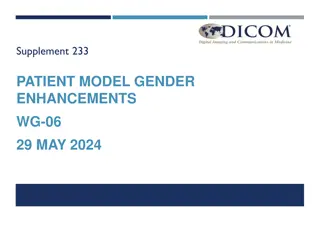Gender Analysis in Time Use for Policy Decisions: Insights from Italy
The Italian strategy of time use gender analysis reveals a significant gender role imbalance in household work, with women bearing the main burden throughout their lives. Gender differences in time use emerge early and intensify with marriage and parenthood. The analysis, presented at the Beijing Conference, highlighted the need for policy interventions to address gender disparities in time use.
Download Presentation

Please find below an Image/Link to download the presentation.
The content on the website is provided AS IS for your information and personal use only. It may not be sold, licensed, or shared on other websites without obtaining consent from the author. Download presentation by click this link. If you encounter any issues during the download, it is possible that the publisher has removed the file from their server.
E N D
Presentation Transcript
Innovations in Time Use gender analysis for policy decisions: the Italian strategy Linda Laura Sabbadini
The long history of the Time use survey in Italy It is also a long history of time use data analysis The Italian National Institute of Statistics (Istat) carried out the first survey in 1989, followed by the 2003, 2008 and 2014 surveys. For the first time, the time spent in household work (housework+care) by all the household members was measured Main results: A very high asymmetry of gender roles in couples Working woman is in charge of 82% of the time devoted to household work. Linda Laura Sabbadini
Department of Equal Opportunity and Istat carried out a life course analysis on time use and gender roles (1994) Gender differences begin since childhood Gender differences remain evident during adolescence The jump in gender difference emerges with marriage and in particular with birth of children: the mother's life and her time use change completely the father's life tend to stay essentially the same Women never retire from household work - even when are elderly -, men do Linda Laura Sabbadini
The birth of children: a critical event women cut their leisure time and sleep to devote an extra hour of household work to each child for mothers, the household work is an increasingly part of the daily life while the leisure time becomes residual for fathers, the paid job is the main part of everyday life while the time spent on household work is very short or practically inexistent mothers carries not only the burden of housework and childcare but also the burden of caring for their husbands: single mothers save more than an hour a day thanks to the absence of a partner Linda Laura Sabbadini
The results of the analysis were presented during the Beijing Conference The publication Different times - the use of time for men and women in today's Italy was translated into four languages (English, French, German and Spanish) and presented during the international women conference in Bejing (1995) It was distributed during the conference and discussed in several workshops organized by INSTRAW and UNSD It was one of the first experiences of life course gender analysis and it became also very useful to design policies Linda Laura Sabbadini
A step forward in the 90s : the integration of analysis on the informal help and solidarity networks Time use survey correctly measures the number of hours spent on household work but it is not the best instrument to measure the time spent on helping non-cohabiting people (elderly parents, grand-children, etc.), because often this is not a daily activity. To measure these flows of aid, in 1983 a specific sequence of questions were introduced in the first household survey on households behaviors and the survey was repeated in 1998. By comparing the results, a critical situation emerged: the caregivers increased in number but both the number of helped households and the number of hours spent to care other households decreased. Linda Laura Sabbadini
Grandmothers: the most stressed link in the female solidarity chain Women appear overwhelmed by the household work: to completely sustain the burden, they have started to share with other caregivers, but this sharing is still not sufficient to cover all the needs The average age of caregivers is increasing The grandmothers one of the pillars of the Italian Welfare System - are increasingly involved in caring for both grandchildren and (often non-self-sufficient) elderly parents; these requests for help tend to come into competition The analysis has brought out several women daily life criticalities that policy makers couldn t ignore In 2000, the law on parental leave was enacted and it includes an article making the Time Use Survey mandatory every 5 years. The law represents an important result of the analysis Linda Laura Sabbadini
THE ITALIAN CASE: MAIN CHANGES IN THE LAST 25 YEARS Asymmetry index in household work for parents aged 25-44 living in dual earner couples, by type of activity Years 1988-1989, 2002-2003, 2008-2009, 2013-2014, in percentage Asymmetry index: how much of the time spent by both partners in household work is played by women (50%= EQUAL DIVISION OF WORKLOADS). During time the index decreases more because women reduce the household work than because men increase their contribution. There are positive signs for gender equality in 2014 for parents aged 25-44 living in dual earner couples: for the first time the asymmetry index in household work falls below the 70% threshold. 9 Linda Laura Sabbadini
THE ITALIAN CASE: MAIN CHANGES IN THE LAST 25 YEARS The differences in household work for parents aged 25-44 living in dual earner couples by gender and type of activity Differences between Year 2013-2014 and Year 1988-1989 in minutes Mothers greatly reduced the time spent in housework (-1h10 ) while increased childcare (+41 ). Fathers slightly increased the time spent in housework (+13 in 25 years) but a higher increase is observed for the time spent in childcare (+33 ). 10 Linda Laura Sabbadini
New questions, new analyses Which characteristics in 2014 show the highest impact on the level of equity in the gender distribution of household work in dual earner couples? (Multiple regression models - Cappadozzi, Sabbadini, Spizzichino 2017) Linear regression models were applied with Asymmetry index in household work as dependent variable. Explanatory variables: 1. gender gap in earnings (relative resources approach) 2. gender gap in time spent in paid work (time availability perspective) 3. partner's opinion on the traditional male-breadwinner model of family (gender ideology perspective) other controlled characteristics : 1. geographical area , 2. w. age class, 3. w. educational level, 4. m. professional status, 5. presence of young children (0-13), 6. day of the week of the diary. 11 Linda Laura Sabbadini
Results Asymmetry index coeff. Sign. The hypothesis of relative resources is fully confirmed: gender asymmetry reduces by an average of 3.8 points when women earn more than men Gender gap in earnings (Ref. She earns less) She earns more Same earnings Gender gap in time spent in paid work (Ref. She works less during the week) She works more during the week Same working times during the week Daily time spent working in minutes Daily time spent in paid work by man Daily time spent in paid work by woman Opinion on traditional male- breadwinner model Male disagreement (Ref. Agreement) Female disagreement (Ref. Agreemnet) Context variables controlled Geographical area (Ref. South) North Center Female age class (ref. 55-64 ) 25-34 35-44 45-54 Female educational level (Ref. Up to lower secondary) High Upper Secondary Male professional status (Ref. self-employed) Executive, employer, professional Middle management, white collar Blu collar, apprentice Presence of young children (0-13) (ref. No) Yes Day of the diary (Ref. Sunday) Week-day Saturday -3,84 *** -0,18 The hypothesis of time availability is not fully confirmed: gender asymmetry reduces when the woman works less or like the man (in terms of number of weekly hours ), but this effect is not very significant. The hypothesis of gender ideology is fully confirmed: the gender asymmetry reduces by an average of about 4 points when the man disagrees with the male-breadwinner model. -1,28 -1,96 * 0,05 *** -0,04 *** -3,95 *** -1,66 * -5,76 *** -4,38 *** Context variables effect 1: the presence of young children increases a more equitable division of tasks between partners, reducing female burden by about 3 points. -5,48 *** -2,44 * -0,70 Context variables effect 2: female burden reduces of 4 points if she has an high educational level or a white/blue collar partner. -4,07 *** -0,91 -0,40 -3,71 *** -4,52 *** Context variables effect 3: Gender asymmetry reduces of about 6 point if the couple lives in the Northern Italy (with respect to the South) , or if the woman is 25-34 years old (with respect to female aged 55-64). -2,94 *** -2,54 * -6,03 *** Intercept 83,79 *** 12 Linda Laura Sabbadini R2 *p<0,05; **p<0,01; ***p<0,001 0,36
Main results from regression analysis Factors showing the highest association with gender equity are: Female young age High female educational level Male white/blue collar Male disagreement with traditional gender roles Small gender gap in earnings The presence of young children (younger than 14 years) Living in Northern Italy The hypotheses of relative resources and gender ideology are fully confirmed, while the hypothesis of time availability is not fully confirmed. 13 Linda Laura Sabbadini
New questions, new analyses How much of the observed change in time spent in household work by adult couples is due to a change in behaviors? (1988-89 vs. 2013-2014) Linear regression models: time spent in household work as dependent variables. Explanatory variables:1.geographical area,.age class,.educational level,.employment status, 5. economic sector, 6.presence of young children (0-13), 7.number of children, 8.day of the week Distinct models for survey edition (1988-89 and 2013-14) and sex (M and F) Shift & share* analysis to distinguish the structural effect from behavioral effect: behavioral effect the structure of the population remains constant (88-89 edition), with the variation of parameters from the model 88-89 to the model 13-14. structural effect the parameters of the model remain constant (88-89 edition), with variation in structure from the model 88-89 to the model 13-14. Interaction effect residual component due to the interaction between the behavioral variation and changes in population structure. 14 89= 14 89+ ?=1 ? ? ? ??89 ?14 ?89 + ?=1 ?89??14 ??89+ ?=1 ?14 ?89 ??14 ??89 14 *Bianchi et. alt (2000); Gershuny J. (2000); Carriero R. (2008 e 2016); Cappadozzi, Sabbadini. Spizzichino (2017) Linda Laura Sabbadini
Results Behavior or structural change? Changes in time spent in household work (in minutes) Changes in time spent in household work by type of change (in percentage) Male Female Male Female 37.2 5.2 6.8 26.5 21.8 8.1 38.3 2.5 -3.4 -25.3 71.4 56.5 -37.3 -66.0 Total change Behavioral change Struttural change Mix Behavioral change Struttural change Mix For men changes in time spent in household work are mainly due to a change in their behavior (71.4%); structural changes represents a minority (21.8%). For women, changes are due to changes both in the population structure (employment rates and education levels) and behaviors. 15 Linda Laura Sabbadini
The importance of the Italian strategy During the last decades the time use survey become a strategic source of information for Istat and for the Country and it is now regulated by law The obtained results effectively answer policy needs The survey has been improved both in methodology and quality, but also the strategy of analysis has advanced. The improvement of quality and analysis pushes policy makers to a more extensive use of data to design policies Using data to implement policies in its turn stimulates the improvement of surveys and analysis. In particular, investing in measures innovation and time use analysis helps to improve gender policies. 16 Linda Laura Sabbadini























